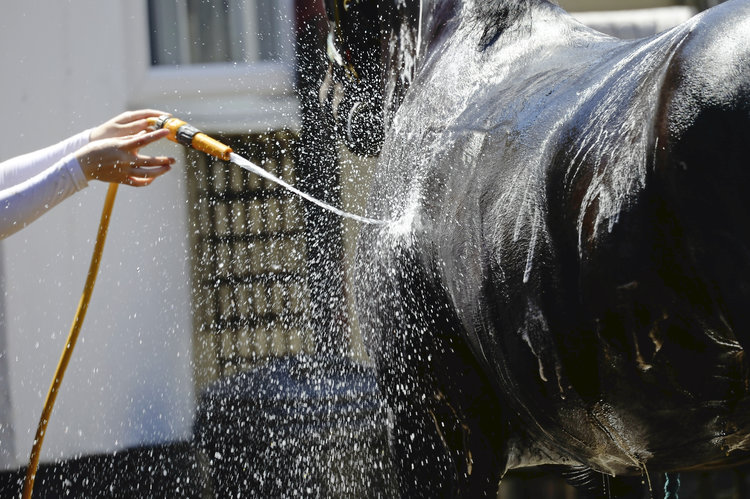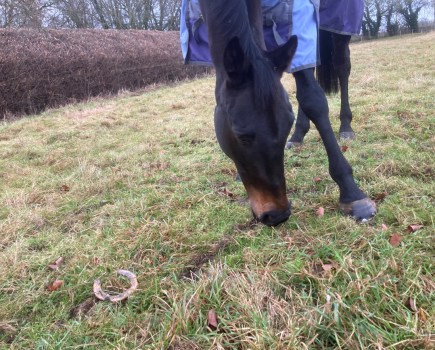During hot weather, preventing our horses from overheating is a big concern and we need to adapt how we take care of them accordingly. Horses normally cool themselves by sweating — the sweat evaporates from the skin surface, causing a cooling effect. However, sweating alone isn’t always enough to bring their body temperature down quickly, and temperatures can climb to dangerous levels, causing heat exhaustion. This can lead to brain damage, organ failure and other serious, potentially fatal problems. We often associate hot horses with sweating alone, but their breathing can indicate their temperature.
“There is a misconception that when horses blow hard after exercise, they are struggling to get enough oxygen, but they’re not. By the time a racehorse pulls up from a race, their blood oxygen will be back to normal levels,” says equine scientist Dr David Marlin. “What drives their breathing is their temperature, so blowing is an indication of high body temperature.”
Other signs of high body temperature are ataxia (wobbling), being hot to touch, excited, stressed or depressed and lethargic/uninterested in surroundings. “It isn’t just exercise that can cause horses to overheat. They can get very hot in situations such as when stuck in a horsebox or hot stable on a very warm day,” adds David.
How to cool down a hot horse
The quickest way to cool horses is to continually pour cold water on them. Whether from a hose or a river or pond, it’s about the volume of water you can get on them.
“Horses that have just finished a race or cross-country round or even dressage test can be very hot, and regardless of the time of year, you will see horses being cooled quite aggressively with water after racing,” says David. “It is by far the most effective and quickest way of bringing a horse’s temperature back down to normal.”
David explains that it’s not so much about the temperature of the water (10-25°C is fine) you apply, but more about the amount you put on.
“Studies show that continuous application of water removes heat through conduction — the direct movement of heat from the horse into the water. This happens due to the big difference in temperature between the horse (surface temperature 40°C or higher) and the water,” he says. “If the temperature of the water is the same as that of the horse, it will only cool the horse by evaporation, which takes much longer than conduction.”
Don’t scrape water off!
Most people have a sweat scraper in their grooming kit — but it is actually useful when it comes to cooling down a hot horse? It’s an age-old debate and no doubt you’ll hear it asked on the yard or discussed on social media again this summer too. Here is the answer: scraping water off your horse will not help to cool it down. It is far more effective to leave the water on the horse, says David.
“Conduction removes heat significantly faster than evaporation,” he explains. “When you scrape the water off your horse, you reduce the capacity for conductive heat transfer. Leave the water on your horse on hot days and it will help it to stay cooler for longer.”
Recovery signs to look for
Spraying horses with the hose briefly or pouring a bucket of water over them before they get turned out will help to keep the horse cool for a while on a hot day through evaporation, but it is not effective at cooling a hot horse quickly. David says to keep cooling until you start to see recovery signs in your horse.
“The best way to tell if your horse has lowered its temperature is to check if his breathing has returned to a normal rate,” he says. “You can also check his other vital signs, such as heart rate and temperature using a thermometer, although rectal temperature often lags behind other signs of recovery. This is why it is important to know what your horse’s ‘normal’ vitals are so you know when they are higher or lower than usual.”
As David explains, there are no downsides to cooling a horse in this way, so you can’t over-water.
“Obviously, if your horse starts shivering, you’ve possibly made him a bit too cold, but you can’t really overcool,” he says. “As part of your cooling process, it’s also important to allow the horse to drink. They will have a strong will to drink as soon as they have finished exercise. Don’t offer them really cold (below 10°C) or really warm water (above 35°C) — horses prefer to drink water at around 25°C. It won’t hurt them to drink cold or warm water, it’s just that they prefer to drink normal temperature water, and will drink more of it.”
Signs of heat stress in horses
Heatstroke can happen in horses, and high temperatures and hot weather are key triggers. Symptoms to look out for in your horse include:
- Restlessness/lethargy
- Rapid pulse and breathing
- Increased sweating
- Excessive salivation
- Redness of the tongue and oral area
- High body temperature
- Erratic heart beat
- Muscle spasms
- Stumbling gait, and in extreme situations, collapse
If you see these signs, or are in any doubt, call your vet immediately.
“Most horses will cope fine with our hot weather in the UK, but older horses, young horses, horses with health issues such as heart disease, equine asthma, Cushing’s and laminitis, or colic-prone and overweight horses, may not cope so well,” says David. “In the UK, we don’t have to worry too much about very hot and humid temperatures, and during the cooler months, horses can get hot after strenuous work but will cool quickly as the ambient temperature is low. Where it becomes crucial is when you have a very hot horse and the temperature is hot too.”
Humidity and electrolytes
Humidity can play a big role in the cooling of horses, as David explains: “The higher the humidity, the less evaporation of sweat there is. Cooling by continuously applying water becomes more important in hot and humid climates because the horse can only cool itself to some degree by evaporation.
“In the UK, we typically have cooling when the horse loses heat by convection because the air temperature is lower than its skin temperature, but when we put cold water on, we are also removing heat by conduction. Horses in humid conditions will be uncomfortable for a longer period of time, will recover much slower, and will have an increased risk of heat-related illness if left to cool naturally when hot.”
In hot weather, horses will sweat more and lose more electrolytes. “It is important to replace electrolytes as most horse diets are deficient in sodium, so for a 500kg horse I would add 25ml of salt a day, and, according to the level of work, a balanced electrolyte. You want to provide electrolytes in a balance that they are lost in the sweat. It’s better to give in slight excess than to not have enough, as the horse’s kidney will sort out any excess.”
How to help a horse stay cool
Help keep your horse comfortable in hot weather by doing the following…
- If you have brick stables with ventilation, then horses may be better in than out. Wooden stables can get very hot in the day. If you have paddocks with tree shelter or open field shelters, then horses may be more comfortable out — although many horses don’t use them.
- Unless you are specifically trying to acclimatise to heat, avoid riding in the hottest parts of the day during the summer — around 10am to 8pm in the UK. Horses in the UK are not currently acclimatised to temperatures above 30°C.
- Clean water with no additives must always be available. There is an increased risk of impaction colic if water intake is reduced. If your horse is a poor drinker then adding in 1 x 25ml salt should help encourage increased drinking. A soaked feed in their bucket can help boost hydration levels too.
- If your horse or pony seems uncomfortable in hot weather, hose them off and allow them to dry naturally. Don’t scrape the water off. You can do this three to four times a day.
- If you see a horse or person or dog with heatstroke, cool them down by hosing/spraying water from the outside or house water supply (usually 10-20°C), or from a river or pond — or even cold bottled water. It doesn’t have to be ice cold to be effective, as long as you put a lot on.
Cooling down in cold weather
Even if we’re not experiencing a heatwave, horses can still get hot through exercise, including in winter, so if your horse is covered in sweat, feels hot and is blowing hard, they need cooling.
“Apply the same principles of covering the horse with water until it starts to feel cool again,” says David. “It will cool down quicker in winter than in summer, and once the horse has cooled down, you can then consider rugging to prevent your horse getting too cold.”
Beware cooling myths…
From giving horses heart attacks to making them hotter by leaving water on them, there are many myths circulating about cooling horses. Here, David clarifies fact from fiction…
Cooling hot horses with cold water does NOT…
- Cause muscle damage
- Cause laminitis
- Induce shock
- Give horses heart attacks
- Prevent them from cooling by constriction of skin blood flow
Water left on horses does NOT…
- Insulate and prevent heat loss
- Cause them to overheat
It is NOT more effective to…
- Start at the feet and work up
- Scrape water off while cooling (it actually causes horses to warm up)
- Focus on large blood vessels
- Cover the horse with wet towels
Dr David Marlin’s members area on his website provides access to science-backed information spanning a wide range of horse-related matters, including webinars, latest research findings, independent product trials and celebrity interviews, with the additional opportunity to join a friendly, supportive private community of fellow horse lovers. Pay-monthly membership is £8. Find out more and join here.









